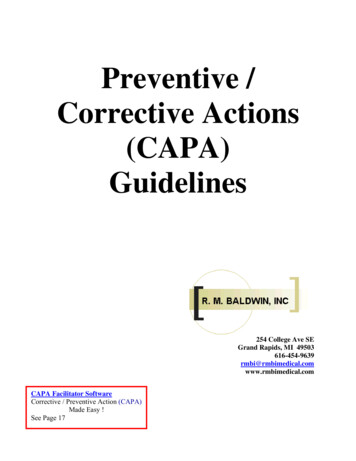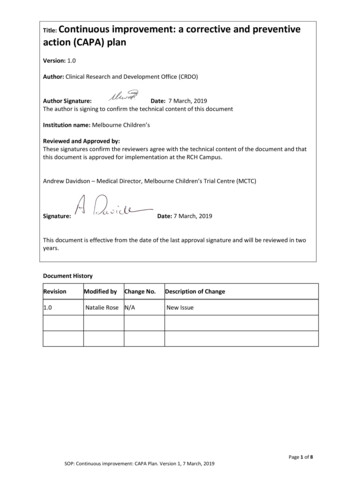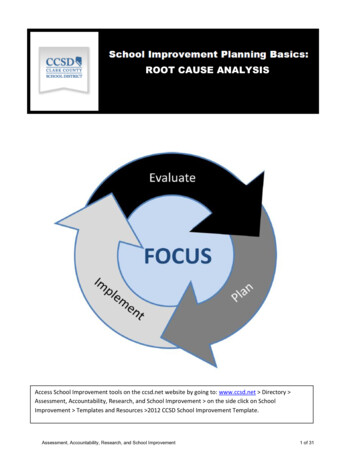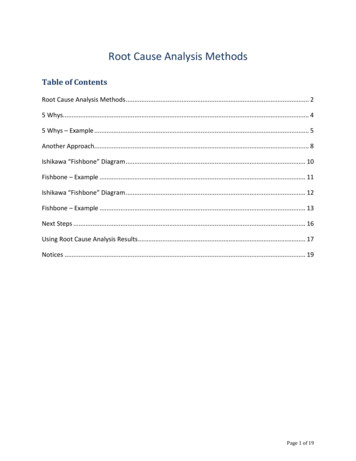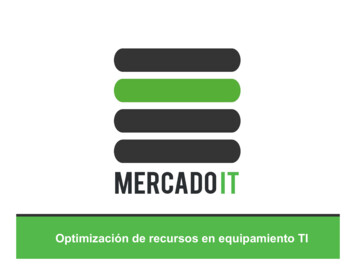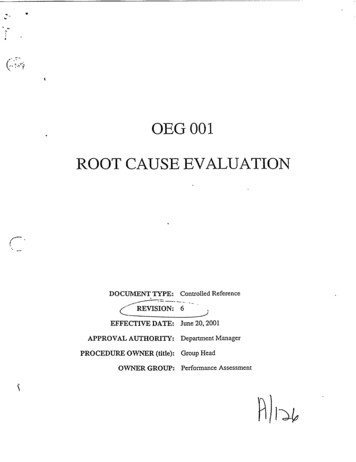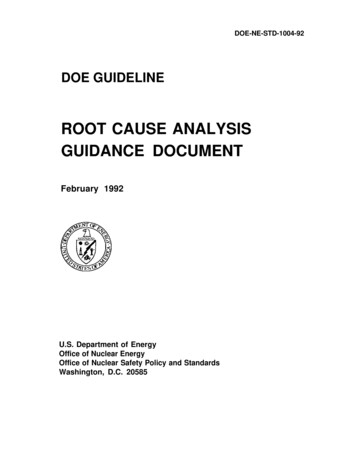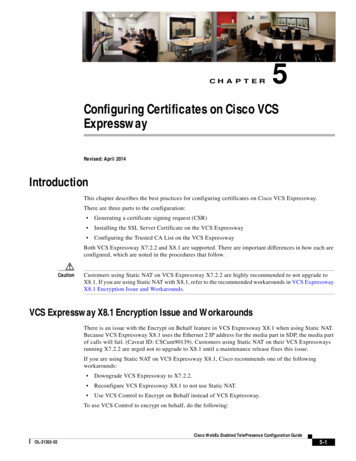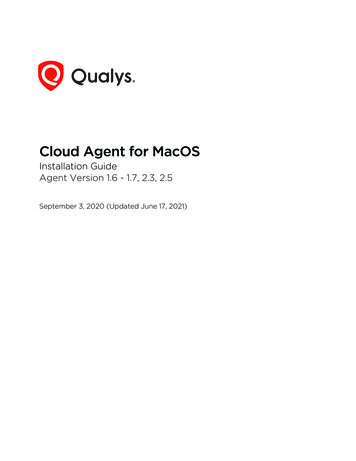
Transcription
THE GUIDE TO CAPA& ROOT CAUSEANALYSIS INFDA-REGULATEDINDUSTRIES
TABLE OFCONTENTS4Introduction5CAPA 101: A Brief Summary of the Basics7What FDA Expects From Your CAPA Process9Root Cause Analysis: A Practical Perspective12 The Case For Cross-Functionality WhenConducting Root Cause Analysis14 An Informed Approach to Addressing andPreventing “Human Error”17 Determining When CAPA is Appropriate19 How CAPA Interfaces With Your QMS20 The Anatomy of an Effective and CompliantCAPA Form23 An Adaptable CAPA Model27 Common CAPA Procedure Problems29 Preventive Action & Risk Management31 The Value of a Third Party ConsultantThe Guide to CAPA & Root Cause Analysis in FDA-Regulated IndustriesTheFDAGroup.com 2
MEET THE CONTRIBUTORSLarry Stevens, RACLarry Stevens, RAC, has held almost every fieldposition within FDA during his 21-year career withthe Agency. He has over 18 years of experience in themedical device industry, rising from an RA Managerto Vice President of RA/QA/Clinical for major class IIIdevice manufacturers.He specializes in planning, creating, and auditingquality systems as well as creating clinical plans,including protocol development, case report formdevelopment, and implementing and managingclinical trials. He also assists in design control tomeet FDA requirements. Larry is a professionalspeaker who regularly trains on all aspects of FDArequirements while offering practical, successfulsolutions to FDA problems.Brian DenseBrian Dense brings over 25-years of industryexperience, with more than 20-years working directlyin quality systems and assessing compliance withFDA 21 CFR Part 820, Parts 210 & 211, Part 58, ISO13485 and ISO 9000.Brian is skilled in implementing, managing andmaintaining complete quality systems to meet FDAregulations and ISO 9000 and ISO 13485 standards aswell as regional and international supplier auditing,supplier controls, nonconforming product, complainthandling and investigation and corrective andpreventive action (CAPA.)The Guide to CAPA & Root Cause Analysis in FDA-Regulated IndustriesTheFDAGroup.com 3
INTRODUCTION“Insufficient corrective and preventive action procedures” (CAPA) hasconsistently topped the list of most common FDA inspectionalobservations within the medical device industry since fiscal year 2010.Its prevalence as the top problem year after year makes it clear thatmany device companies have issues, both known and unknown, withintheir CAPA programs. While the immediate compliance threats areobvious, less so are those that leave companies vulnerable to seriousquality system issues that can grow and metastasize under the radarof their quality management system, putting both patients and theirbusiness at risk.This white paper tackles CAPA from a slightly different perspective thanmost are used to seeing in industry publications and seminars. We’vegathered insights from quality and compliance experts who have seenit all and fixed it all firsthand. In addition to exploring the solutions thathave proven to be effective in the field, we’ll also examine one, if not the,most pivotal component of CAPA: root cause analysis.The Guide to CAPA & Root Cause Analysis in FDA-Regulated IndustriesTheFDAGroup.com 4
CAPA 101: A BRIEF SUMMARY OF THE BASICSWhat is CAPA?Corrective and Preventive Action (CAPA) was first formally introduced by the U.S.Food and Drug Administration (FDA) in 2006 as a component of the Quality SystemsGuidance. This guidance would go on to form the basis of the ICH Guideline Q10.Since then, it’s found its way into the EU GMP Guide, laying out the CAPA processwithin the pharmaceutical space.For medical device companies, CAPA is addressed in ISO 13485, which unlike Q10,divides the concept into its two concepts: “Corrective measures” (addressed inChapter 8.5.2) and “Preventive measures” (addressed in Chapter 8.5.3). Despite theseparation of these processes, both are required to be documented and evaluatedto demonstrate improvement and preventive action, making CAPA the practicalprocesses by which both are united. With this in mind, we’ll be treating it as oneconcept here.What is CAPA used for?A CAPA procedure is used to address deviations or problems that have alreadyoccurred and to put measures in place to avoid future deviations or problems. Thisentire process of analyzing errors, deviations, and their effects can––and should––be carried out as a component of broader risk assessment rooted in a well-definedand documented risk management program.CAPA-triggering deviations can originate from a variety of sources within a qualitymanagement system, such as internal audits, customer feedback, or in the mostserious cases, safety or security-related incidents that result in faulty products dueto inadequate controls.No matter why or where CAPA is initiated, it should always begin by identifyingand taking any immediate actions that will stabilize the situation and limit itsfurther effects. This is where an honest and accurate assessment of its severity isabsolutely crucial. In the worst case scenarios, this could mean an immediate haltto production and distribution of all impacted products.The Guide to CAPA & Root Cause Analysis in FDA-Regulated IndustriesTheFDAGroup.com 5
What does a typical CAPA process look like?In most cases, a CAPA is executed much like a typical PDCA (Plan-Do-Check-Act) cycle:1. Begin with a detailed problem description by accurately evaluating anddocumenting it.Similar to the planning stage of the PDCA cycle, all CAPAs should startby describing the problem in detail, ensuring everything is documentedaccurately.2. Perform a root cause analysis.Once the problem is clearly defined, determine its root cause by performing athorough root cause analysis.3. Implement, verify, validate, and document necessary corrective andpreventive measures.This change should seek to remedy the root cause of the problem and ensureno further problems will occur. This could be a change in the productionprocess, a training improvement, or another transformative measure.4. Check for effectiveness and evaluate success.Finally, the effectiveness and success of the measures implemented is checkedand evaluated accordingly. Like with the “Act” phase of PDCA, this justifieswhether and why the CAPA process was successful. If the CAPA process wasnot or only partially successful, another CAPA process must be initiated. Asuccessful CAPA process may result in a re-evaluation or addition to the riskanalysis.The diagram below offers a simplified look at the general steps of CAPA. Anadaptable model for CAPA is offered later in the paper.NOCAPAStartExecutionImmediateMeasureError description andtroubleshootingNOEndThe Guide to CAPA & Root Cause Analysis in FDA-Regulated IndustriesYESAnalysis ofthe cause ofthe errorCAPA processsuccessful?Establishing/ Validation/ CorrectiveActionsReview ofthe measureReleaseof themeasure?YESEnforce ofthe measureTheFDAGroup.com 6
WHAT FDA EXPECTS FROM YOUR CAPA PROCESSGiven the numerous inspectional observations citing insufficient established CAPAprocedures, it’s worth revisiting what regulators expect to see from your process.In a 2014 presentation, FDA’s Joseph Tartal described the basics of effective correctiveand preventive action—a resource every company should use to evaluate againsttheir own processes. Among many important points, one stands out as particularlyuseful when ensuring your procedure meets regulators’ expectations:“Manufacturers should consider that their corrective action andpreventive action documentation can demonstrate to FDA thatthe manufacturer’s quality system is effective and enables themanufacturer to identify problems quickly and implement effectivecorrective and preventive actions (or not).”In addition to helping manufacturers meet the broad expectations for effectiveCAPA, FDA also makes public its own inspectional guide, which lays out the specificobjectives for investigators when evaluating a device company’s CAPA system andrelated documentation. We’ve summarized its main points below.This should serve as your ultimate preparedness checklist when evaluating yourCAPA processes for compliance with FDA regulations.1. Verify that CAPA system procedure(s) that address the requirements of thequality system regulation have been defined and documented.2. Determine if appropriate sources of product and quality problems have beenidentified. Confirm that data from these sources are analyzed to identify existingproduct and quality problems that may require corrective action.3. Determine if sources of product and quality information that may showunfavorable trends have been identified. Confirm that data from these sourcesare analyzed to identify potential product and quality problems that may requirepreventive action.4. Challenge the quality data information system. Verify that the data received bythe CAPA system are complete, accurate and timely.The Guide to CAPA & Root Cause Analysis in FDA-Regulated IndustriesTheFDAGroup.com 7
5. Verify that appropriate statistical methods are employed (where necessary)to detect recurring quality problems. Determine if results of analyses arecompared across different data sources to identify and develop the extent ofproduct and quality problems.6. Determine if failure investigation procedures are followed. Determine if thedegree to which a quality problem or nonconforming product is investigated iscommensurate with the significance and risk of the nonconformity. Determineif failure investigations are conducted to determine root cause (where possible).Verify that there is control for preventing distribution of nonconforming product.7. Determine if appropriate actions have been taken for significant product andquality problems identified from data sources.8. Determine if corrective and preventive actions were effective and verified orvalidated prior to implementation. Confirm that corrective and preventiveactions do not adversely affect the finished device.9. Verify that corrective and preventive actions for product and quality problemswere implemented and documented.10. Determine if information regarding nonconforming product and qualityproblems and corrective and preventive actions has been properly disseminated,including dissemination for management review.Action items: Evaluate your current CAPA process on the criteria listed above. Highlight and remediate any gaps that exist between regulatoryexpectations and current processes. Follow up on all changes with necessary documentation, training,or other actions needed to implement, support, and maintain thoseimprovements. Note any gaps or improvements that require third party assistance froma qualified CAPA professional and contact a firm to pair you with theappropriate resource.The Guide to CAPA & Root Cause Analysis in FDA-Regulated IndustriesTheFDAGroup.com 8
ROOT CAUSE ANALYSIS: A PRACTICAL PERSPECTIVEWhile much attention is given to the tools, techniques, and methodologies for“extinguishing the problem at the source,” much less attention is given to thefact that none of them will be effective if they aren’t implemented properly. Thefactors for proper use boil down to two fundamentals every organization shouldimmediately evaluate against and enhance if room for improvement exists:1. Having the right team(s) in place to collect data and conduct theinvestigation in order to determine what factors should and shouldn’t beincluded in analysis2. Crystal clear communication with the proper measures in place tominimize bias and the role of interorganizational politics in obstructingthe free and open exchange of facts and ideasWithout these two fundamentals, even the best root cause analysis process willlikely fail to properly identify and address the true root causes of the problemsaffecting your products and quality system.Once a foundation is established on these two important pillars, turn your attentionto the major challenges companies face in conducting root cause effectively. Challenge #1: Devoting too little time to investigating and determining the rootcause of an issue Challenge #2: Simply restating the problem statement as the root cause of theproblem Challenge #3: Not having a reliable set of tools and methods for carrying outan effective investigation Challenge #4: Failing to reference the tools you do use in your CAPA procedure,thereby opening the door to regulatory scrutinySince each company faces their own set of challenges, prescribing a universal set ofsolutions is impossible. A solution for one organization can end up introducing moreproblems when applied the same way in another. It’s important to reiterate thatthis guide is intended to reveal the realm of possible solutions and improvementsavailable to you—not compel you to use one or another. Given this frame, let’sexplore a topic that’s familiar to many, but provides the critical foundation fromwhich action is taken: root cause analysis.The Guide to CAPA & Root Cause Analysis in FDA-Regulated IndustriesTheFDAGroup.com 9
“In many organization, politics are allowed to influence theCAPAs simply because there are too many people involved in theapproval process—approval to actually open a CAPA, or approvalto finish one. Very often there are too many people, or the wrongpeople, in the approval process. I’ve seen real problems get sweptunder the rug because somebody won’t approve the effort to goforward with it. I’ve also seen good solutions get shot down on realproblems,because somebody didn’t want to spend the money orthe time. I would be cautious about adding too many levels and toomany people to the process.”Brian DenseA Brief Overview of Root Cause Analysis MethodologiesThere are a number of reliable methodologies for analyzing root cause, however,not all are equally effective in every scenario. Applying the same methodology toevery investigation can fail to go far or wide enough into the problem, underminingthe entire effort.While each methodology deserves to be thoroughly understood by those puttingthem to use, we’ve summarized the key takeaways for three of the most commonmodels to help you choose the right one for a given scenario. Fault Tree Analysis (FTA): This is a deductive procedure used to determine thevarious combinations of hardware and software failures and human errors thatcould cause undesired events (referred to as top events) at the system level.Advantages:FTA values the judgement of experts from many disciplines and provides acommon perspective on a given problem.Disadvantages:FTA relies on multiple expert opinions and judgements at various stages,making it prone to inaccuracy. For larger systems, quantitative analysis mightbe so complex, it requires computer algorithms to accomplish.The Guide to CAPA & Root Cause Analysis in FDA-Regulated IndustriesTheFDAGroup.com 10
Recommended Applications: Analyzing and forecasting system reliability, maintainability, and safety Understanding the logic leading to a “top event” or undesired state Demonstrating compliance with system safety and reliability requirements Prioritizing multiple contributors which led to a top event or undesired stateFishbone Diagram: Also called a “cause and effect” or “Ishikawa” diagram(among others), a fishbone diagram is a visual tool for looking at cause andeffect. A problem or effect is displayed at the the “head” or “mouth” of the fishand possible contributing factors are listed on the “bones” under various causecategories. These models work best when the “head” of the fish contains a verydetailed problem statement. This helps eliminate scope creep of the team’sdiscussions. What happened? When? Where? These can help narrow the focusto solve the problem.Advantages:Fishbone diagrams are particularly useful for organizing potential causes,helping teams think through causes they might otherwise miss, and providing aliving document that shows the status of all potential causes and whether theyhave been proved, disproved, or acted upon.Disadvantages:Fishbone diagrams are by nature a divergent approach to problem solving, sothey make it possible for teams to expend a lot of energy speculating about apotential cause that may have no effect on the problem.Recommended Applications: Directing a team to focus on identifying all possible categories and consideralternative causes Refocusing a team on the causes of a problem rather than the symptoms Improving product design Preventing quality defects Identifying potential factors causing an overall effect5 Whys: The 5 Whys is arguably the simplest technique for root cause analysis.It can be very effective when answers come from people who have hands-onexperience in the process being examined. It is remarkably simple: when aproblem occurs, you drill down to its root cause by asking “why?” five (or more)times. Then, when a countermeasure becomes apparent, you follow it throughto prevent the issue from recurring.The Guide to CAPA & Root Cause Analysis in FDA-Regulated IndustriesTheFDAGroup.com 11
Advantages:This is essentially a simpler form of a fault tree analysis, making it a straightforwardprocess when investigating specific accidents instead of chronic problems.Disadvantages:Results can be non-reproducible and inconsistent. For instances, two teamsanalyzing the same issue may reach a different solution. It also leaves the dooropen to stopping short of reaching the true root cause.Recommended Applications: Resolving simple or moderately difficult problems Resolving issues involving human factors Resolving issues where statistical analysis is not needed or possibleAction Items: Evaluate the current methodologies and tools utilized when investigatingroot cause. Determine whether current processes suffer from the challengesdescribed and consider ways to overcome them. Determine how well current processes ensure the best methodologiesand tools are selected from a diverse set of options based onapplicability to specific goals. Adjust processes as necessary to include currently unusedmethodologies and tools given staff are fully trained and confident inusing them. Consider how prior problems could have been solved better ifaddressed with another methodology or tool and prepare to employthem if similar issues arise in the future.THE CASE FOR CROSS-FUNCTIONALITY WHEN CONDUCTING ROOTCAUSE ANALYSISToday, it’s common for organizations to place high value on taking personalresponsibility for quick problem resolution. While this value is rooted in goodintention, placing the focus at least in part on speed must be done with extremecaution to ensure root causes are fully identified and resolved. Speed, in this case,The Guide to CAPA & Root Cause Analysis in FDA-Regulated IndustriesTheFDAGroup.com 12
is a risky substitute for thoroughness. When this risk is ignored, the incentive tokick the can down the road in the interest of getting it cleared and closed as fastas possible begins obstructing your ability to conduct a thorough investigation andanalysis. Rather than resolving problems, they’re simply moved from one functionto another in a dangerous game of hot potato.Processes that give rise to problems are rarely localized to a single departmentor function. In many cases, the more complex a process is, the more functions itcrosses. To truly resolve problems at their root—quickly and completely—a crossfunctional group consisting of stakeholders from all inputs, work tasks, and outputsinvolved must be established to solve the problem from every angle. To be reliablysuccessful, root cause investigation and analysis must start by defining the processin which an issue (or issues) have arisen from one end to the other—evaluating allinputs, work done, and outputs being handed off to the next process. To do thiseffectively, knowledgeable representatives and owners from all functional areasincluding engineering, sales, quality, regulatory, etc., must work together.Cross-functionality is especially important given that the point a problem is detectedis rarely where the root cause truly lies. The further upstream you need to travelto find it, the more you can expect to rely on the knowledge of other functionsyou’re led to when tracing the the principal cause. This is where communicationand cooperation between functions becomes critical. Without a cross-functionalapproach, assumptions made by one function conveniently replace the informedknowledge of another—leading to dangerous gaps in understanding how othersteps in the process are impacted.Creating a cross-functional team may slow down the process and ask more of thoseinvolved, but this added investment is often returned in the quality of the resultsit achieves.Action Items: Evaluate your current root cause analysis process on its degree ofcross-functionality. If needed, revise this process to incorporate more stakeholders fromother functions. To accelerate problem resolution, establish the team’s assignment andtimeline up front.The Guide to CAPA & Root Cause Analysis in FDA-Regulated IndustriesTheFDAGroup.com 13
AN INFORMED APPROACH TO ADDRESSING AND PREVENTING“HUMAN ERROR”Genuine human errors do happen, but they’re cited far more frequently than theyshould be. In truth, most problems that appear to be caused by human error—especially those that occur multiple times—are actually rooted in processes orsystems that when left unchanged, will keep producing the problem despite theconvenient band-aids often placed over them. When human error is identifiedmore frequently than it should be expected to happen, it signals to investigatorsthat problems aren’t being investigated thoroughly enough, thereby shifting theminto problem-hunting mode and opening your quality management system up toeven greater scrutiny.But what about the rare instances where one-time errors are made by otherwisewell-trained personnel following well-defined processes? A moment of inattentiondue to a passing distraction can lead to serious problems. In these cases, thehuman error classification may be justified after a thorough investigation revealsnothing in every possible place there is to look. Again, this conclusion should neverbe jumped to as a convenient way to avoid the important work of problem-solving(as it often is). It should only be considered as a viable justification when everyother possible cause has been exhaustively explored and eliminated.Given this caveat, it’s helpful to arm yourself with a model for analyzing what mightappear to be human errors in order to determine whether actions (or inactions)were deliberate or inadvertent. The outcome can help you determine whether ornot human behavior really is to blame as well as where you might expect to find aproblem elsewhere (such as inadequate training, poor SOPs, etc.) if the root causeappears to be less human than you initially thought upon further analysis.Enter the Skills, Rules Knowledge/Generic Error Modeling System illustrated below.It’s relatively simple, but offers a reliable way to tease out genuine human errorsfrom other problems while pulling real human errors apart even further to revealtheir motivating factors.The Guide to CAPA & Root Cause Analysis in FDA-Regulated IndustriesTheFDAGroup.com 14
Error: Action notas plannedNot doing whatwas ed MistakeSlip (Commission)Errors caused byinattention ormisplaced attentionA simple, frequentlyperformed physicalaction goes wrongRule-based MistakeError: Action asplannedDid the wrongthing believing it tobe rightViolation:NoncomplianceUse of inappropriaterule, misapplicationof rule, or applicationof bad ruleLapse (Omission)Short-term memorylapse - omission of arequired actionKnowledge-basedMistakeErrors caused byinattention ormisplaced attentionHuman ErrorsKnowingly takeshort cuts or fail tofollow proceduresFollowing this model, errors that are shown to be “inadvertent” can be consideredgenuinely “human”, which then fall into one of three categories: skill-based, rulebased, or knowledge-based mistakes.Those that are skill-based can be broken down one more time, into either a slipor a lapse. Both of these point to the same root cause: a lack of attention, whichmanifests itself in two different ways: momentary memory loss or a routine actionthat wasn’t performed.Once more, it’s important to note that these type of errors should not be happeningfrequently. The vast majority of problems that appear to be human error at firstshould lead you elsewhere upon further analysis.Errors shown to fall into one of the two other categories should be viewed througha different lens. In these situations, processes—particularly related to training andoversight should be scrutinized as contributors as explained in the breakdownbelow.The Guide to CAPA & Root Cause Analysis in FDA-Regulated IndustriesTheFDAGroup.com 15
Knowledge-based Errors: These types of errors occur when someone wasmultitasking beyond their limit, or were otherwise unable to devote the focusrequired to accomplish multiple tasks at once. In this situation, identify why theperson was multitasking in the first place. The root cause likely lies here. Were they tasked with doing too many things at once? Is that department under-resourced? Was this individual’s supervisor aware that the person is multitasking beyondtheir limit?Rule-based Errors: These errors are more technical in nature, such assomeone applying an incorrect rounding rule which ultimately generatesan out-of-specification (OOS) result. In this situation, rather than faulting anindividual’s judgement, which may not be at fault, question why the personwasn’t adequately prepared to perform the task correctly. Did they receive insufficient practice in training? Did practice actually reflect the the operations they were performing onthe floor? Does the procedure specify the details to the degree they need to beexplained in order to be performed correctly?Two Places to Look for Systemic “Human” ErrorsWhen errors are revealed to be less “human” upon closer examination, start askingquestions that cast light on how the type of work in question is actually being done.This may lead you to discover the problem may be more serious and widespread,particularly in one of two areas summarized below. DocumentationFDA-regulated manufacturing operations are followed by documentation everystep of the way. If human error is found, take a hard look at your written recordsand ask the questions of them listed below. The real problems may lie in yourprocesses for creating, maintaining, and distributing the documentation thatdrives your quality system. Are change processes long and cumbersome? Are your staff working with out-of-date or obsolete SOPs? Are your SOPs readily accessible? Can employees easily navigate to themand understand the information they need?The Guide to CAPA & Root Cause Analysis in FDA-Regulated IndustriesTheFDAGroup.com 16
Do your SOPs and other documentation align in terminology and structure? Do staff use and trust documentation or is it common practice to seekanswers from other sources? Do procedures given during training match those your staff follow onthe job? CultureOne of the best ways to immediately enhance quality throughout yourorganization is to realize most of the problems being described as humanerrors are something else entirely. Rather than using it as a convenient standin for thorough investigation, use human error as an opportunity to improveyour company’s problem-solving processes. Fast closure rates of inaccuratedeviations don’t demonstrate efficiency, just misguided values on the problemsolving process itself.Replace this metric with a trending reduction in total deviations over time. Thesize of your backlog and closure times are functions of each other and shouldbe handled accordingly. Keep in mind that the lack of a backlog will likely leadinvestigators to look at your closure trends. If your deviation backlog is reducedsignificantly in the weeks leading up to their arrival, they’ll know your methodswere rushed rather than being a natural component of your QMS.Action Items: Conduct an objective assessment of your internal problem-solvingprocesses (ideally with the help of an experienced third party) andremediate accordingly. Replace metrics that establish problematic incentives with goals focusedon long-term trending. Explore ways to improve problem-solving within your QMS to reducebacklogs while thoroughly investigating issues.DETERMINING WHEN CAPA IS APPROPRIATEMany companies suffer from either overusing or underusing their CAPA program—each presenting its own set of risks. Overusing CAPA typically results in an un-endingbacklog of open projects, which prevents issues from being resolved in a timelyThe Guide to CAPA & Root Cause Analysis in FDA-Regulated IndustriesTheFDAGroup.com 17
manner, thereby allowing them to worsen while in queue. Underusing CAPA risksletting issues fly under the radar, which again enables them to grow and becomeharder and more expensive to fix when they’re finally detected.It would be reckless to prescribe hard-and-fast rules for when or when not to opena CAPA, but for those struggling with over- or under-use, some general advice maybe useful for taking immediate initial steps to correct yourself and set the stage forgradual improvement. Ramp up or scale back your CAPA program to deal with systemic orpotentially systemic issues first.While not every problem deserving of a CAPA should be “systemic” in nature,these types of problems are typically a great fit when addressed with CAPA. Ask four questions of the problem:1. Did the incident or event result in injury? If so, CAPA should obviously bemandatory.2. Has the issue, incident, or event occurred multiple times? If so, you likelyhave a system problem on your hands, which should definitely be handledthrough CAPA.3. Can the issue be managed effectively another way? “Ef
2. Perform a root cause analysis. Once the problem is clearly defined, determine its root cause by performing a thorough root cause analysis. 3. Implement, verify, validate, and document necessary corrective and preventive measures. This change should seek to remedy the root cause

